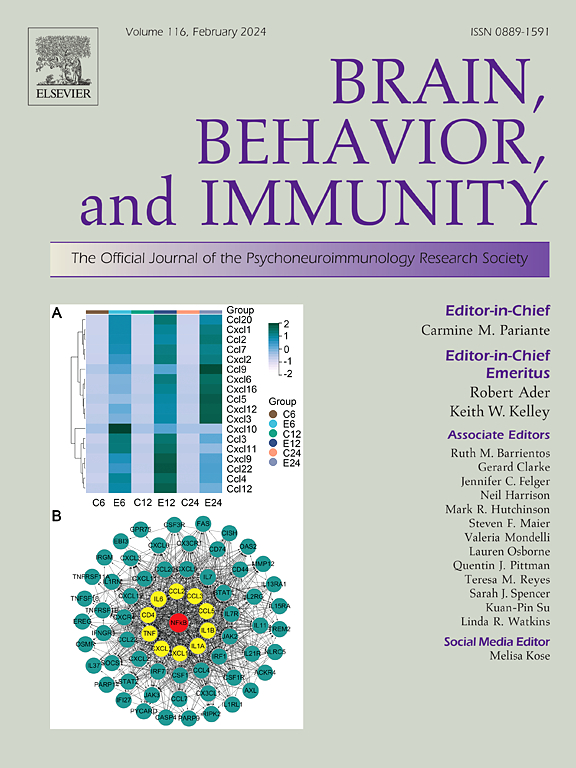A Two-Year cohort study examining the impact of cytokines and chemokines on cognitive and psychiatric outcomes in Long-COVID-19 patients
IF 8.8
2区 医学
Q1 IMMUNOLOGY
引用次数: 0
Abstract
This study investigates the relationship between clinical, sociodemographic, and neuropsychological symptoms and serum cytokine concentrations with long-term cognitive and psychiatric outcomes in long-COVID-19 patients. We reassessed 108 adults who survived moderate to severe COVID-19 at two intervals post-discharge (T1, mean 6.9 months; T2, mean 23.5 months). Baseline sociodemographic and clinical data were collected from hospital records, while cognitive and mental health assessments included psychometric tests such as the Hospital Anxiety and Depression Scale (HADS) and Immediate and Delayed Recall Tests from the CERAD Battery. Serum cytokine levels were measured at T1. Generalized Additive Models (GAMs), Elastic Net Regression (NET), and Psychological Network Analysis (PNA) were used to analyze the data. The GAM analysis revealed significant associations between acute COVID-19 severity and Epworth Sleepiness Score with persistent anxiety symptoms at T2. For depression, both WHO severity class and Eotaxin levels were significant predictors. The Anti-inflammatory Index showed a marginally significant relationship with immediate recall, while age was marginally associated with delayed recall performance. In NET, only anxiety was significantly associated with Epworth Sleepiness Score, WHO severity class, and Proinflammatory Index. PNA did not reveal direct connections between cytokines and neuropsychological outcomes in the graphical model. However, centrality measures indicated that the Proinflammatory Index and VEGF were more central within the network, suggesting they might be important components of the overall system. This study provides insights into the complex role of cytokines and inflammation in long-COVID-19 outcomes, potentially aiding in the identification of biomarkers for diagnosis and prognosis.
一项为期两年的队列研究,探讨细胞因子和趋化因子对 Long-COVID-19 患者认知和精神状况的影响。
本研究调查了COVID-19长期患者的临床、社会人口学和神经心理学症状以及血清细胞因子浓度与长期认知和精神状况之间的关系。我们在出院后的两个间隔期(T1,平均 6.9 个月;T2,平均 23.5 个月)对 108 名中度至重度 COVID-19 存活下来的成人进行了重新评估。基线社会人口学和临床数据来自住院记录,认知和心理健康评估包括心理测试,如医院焦虑抑郁量表(HADS)和CERAD电池中的即时和延迟回忆测试。血清细胞因子水平在第一阶段进行了测量。数据分析采用了广义相加模型(GAM)、弹性网回归(NET)和心理网络分析(PNA)。GAM分析表明,急性COVID-19严重程度和埃普沃思嗜睡评分与T2时的持续焦虑症状有明显关联。在抑郁症方面,WHO严重程度等级和Eotaxin水平都是重要的预测因素。抗炎指数与即时回忆有微弱的相关性,而年龄与延迟回忆表现有微弱的相关性。在 NET 中,只有焦虑与埃普沃思嗜睡评分、WHO 严重程度分级和前炎症指数有明显相关。在图形模型中,PNA 没有显示细胞因子与神经心理学结果之间的直接联系。然而,中心性测量结果表明,前炎症指数和血管内皮生长因子在网络中处于更中心的位置,这表明它们可能是整个系统的重要组成部分。这项研究深入揭示了细胞因子和炎症在长期COVID-19结果中的复杂作用,可能有助于确定诊断和预后的生物标志物。
本文章由计算机程序翻译,如有差异,请以英文原文为准。
求助全文
约1分钟内获得全文
求助全文
来源期刊
CiteScore
29.60
自引率
2.00%
发文量
290
审稿时长
28 days
期刊介绍:
Established in 1987, Brain, Behavior, and Immunity proudly serves as the official journal of the Psychoneuroimmunology Research Society (PNIRS). This pioneering journal is dedicated to publishing peer-reviewed basic, experimental, and clinical studies that explore the intricate interactions among behavioral, neural, endocrine, and immune systems in both humans and animals.
As an international and interdisciplinary platform, Brain, Behavior, and Immunity focuses on original research spanning neuroscience, immunology, integrative physiology, behavioral biology, psychiatry, psychology, and clinical medicine. The journal is inclusive of research conducted at various levels, including molecular, cellular, social, and whole organism perspectives. With a commitment to efficiency, the journal facilitates online submission and review, ensuring timely publication of experimental results. Manuscripts typically undergo peer review and are returned to authors within 30 days of submission. It's worth noting that Brain, Behavior, and Immunity, published eight times a year, does not impose submission fees or page charges, fostering an open and accessible platform for scientific discourse.

 求助内容:
求助内容: 应助结果提醒方式:
应助结果提醒方式:


